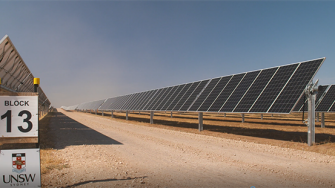UNSW Sydney campus fully powered by its own solar tech
Solar power technology that UNSW researchers pioneered is now the main energy source for the university’s Sydney campuses.
Solar power technology that UNSW researchers pioneered is now the main energy source for the university’s Sydney campuses.

In 2018, then-President and Vice-Chancellor Professor Ian Jacobs announced that UNSW Sydney would achieve net zero emissions from energy use by 2020. In November of that year, the University made this vision a reality when the Sunraysia Solar Farm started exporting electricity to the grid and UNSW's campuses.
The solar farm is located at Balranald in south-west NSW. It’s one of the largest in the world.
UNSW’s School of Photovoltaic and Renewable Energy Engineering (SPREE) was particularly eager to see the farm go live: it is their photovoltaics technology which is now used to light up and power their offices and the rest of the University.
“We were all incredibly proud that UNSW was now powered by 100% solar, utilizing technology developed in our labs and manufactured at scale by our graduates,” Alistair Sproul, head of SPREE, says.
“The icing on the cake was that UNSW did not take advantage of the subsidies on offer and 100% solar was still the cheapest option available, beating conventional electricity from coal and gas."
755,000 solar panels on the farm provide power to more than 50,000 homes.
The farm offsets approximately 430,000 tonnes of carbon dioxide per year.
Sunraysia supplies UNSW’s energy through an innovative Power Purchase Agreement. In addition to renewable electricity, UNSW purchases additional carbon units to offset emissions from natural gas and other fuels.
The University will save 1.25 million tonnes of greenhouse gas emissions over the 15-year term of agreement.
The power agreement specified that the UNSW-dedicated section of Sunraysia Solar Farm, Block 13, must use the UNSW-developed Passivated Emitter and Rear Cell (PERC) solar technology.
UNSW researchers in SPREE, led by Scientia Professor Martin Green, pioneered the world’s first 19% and 20% efficiency solar cells in 1983 and 1985 respectively, eventually taking efficiency to 25%.
“The research was commercialised in the 1990s in China by UNSW researchers, which later allowed solar panels to become affordable at scale,” Professor Sproul says.
“When they were building the farm [in 2019], it’s likely that there was a module which was cheaper. But now, PERC really is the cheapest to make.”
UNSW uses a quarter of the farm’s capacity to meet 100% of its electricity needs, reducing its energy-related carbon emissions to net zero.
Tackling climate change is a key focus in UNSW’s 2025 Strategy. The move follows a UNSW announcement in 2020 that it would divest of all fossil fuel company investments by 2025.
“I feel really proud of the global impact we have been able to have on the solar panel industry with our research,” Professor Green says.
90% of solar cells produced globally are based on PERC technology.
As Australia’s best engineering faculty turns 75, there are just as many reasons why we’ve earned that title. Discover new stories weekly, celebrating the successes that have enabled progress for all.